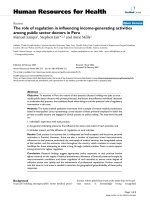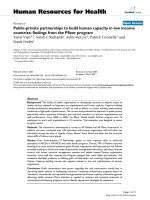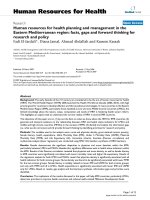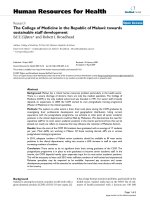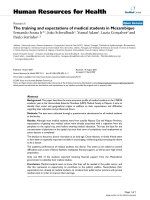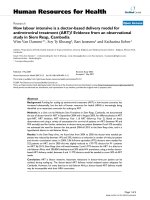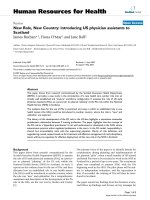Báo cáo sinh học: " New Vibrio cholerae O1 Biotype ElTor bacteriophages" pptx
Bạn đang xem bản rút gọn của tài liệu. Xem và tải ngay bản đầy đủ của tài liệu tại đây (517.47 KB, 4 trang )
BioMed Central
Page 1 of 4
(page number not for citation purposes)
Virology Journal
Open Access
Research
New Vibrio cholerae O1 Biotype ElTor bacteriophages
Anindito Sen
1,2
and Amar N Ghosh*
1
Address:
1
Division of Electron Microscopy, National Institute of Cholera and Enteric Diseases, P-33, C.I.T. Road, Scheme- XM, Beleghata, Kolkata-
700010. India and
2
(Present Address) Laboratory of Structural Biology, Room 1504, Building 50, NIAMS/NIH Bethesda, MD, 20852, USA
Email: Anindito Sen - ; Amar N Ghosh* -
* Corresponding author
VibriophageElectron microscopy
Abstract
We report the presence of three new O1 ElTor vibriophages named AS1, AS2 and AS3, isolated
from the sewage and pond waters of the outskirts of Kolkata. A few phages, named AS4, with
hexagonal heads and abnormally long tails with typical curly projections were also found in the
water samples.
Vibrio cholerae, the causative agent of cholera in humans,
is classified into two serotypes: O1 and nonO1 [1]. The
O1 strains are divided into two biotypes: Classical and
ElTor. Before 1961 most epidemics had been caused by
the classical biotype. But with the passage of time the clas-
sical biotype disappeared from the scenario and the ElTor
emerged as the major biotype causing the Vibrio cholerae
in humans. In 1993, Vibrio cholerae serogroup O139 made
an explosive appearance and caused a severe epidemic in
the Indian continent [2]. The disease cholera spreads rap-
idly to far off places from the epicenter of its emergence.
From the epidemiological point of view it is important to
track down the spread of the disease. Phage typing is a
widely accepted method for tracking down cholera epi-
demic [3]. The international phage-typing scheme of Basu
and Mukerjee [3] includes five phages (I, II, III, IV and V).
But in course of time this typing scheme proved inade-
quate as a large number of Vibrio cholerae strains were
found to be untypeable using this scheme. In order to
overcome this problem a new typing scheme for ElTor
strains was proposed in 1993 [4]. In the recent times vibri-
ophages are found to occur in amazingly in large numbers
in the environment around the globe [5-8] which,
prompted us to search for new cholera phages from the
environmental resources.
Sewage and pond water were collected from different
places from the outskirts of Kolkata. During the study
period the recorded temperature was about 32–38°C and
pH ranged from 7.8 to 10. The sample waters were proc-
essed for phage isolation as described previously [9] using
Published: 11 April 2005
Virology Journal 2005, 2:28 doi:10.1186/1743-422X-2-28
Received: 17 February 2005
Accepted: 11 April 2005
This article is available from: />© 2005 Sen and Ghosh; licensee BioMed Central Ltd.
This is an Open Access article distributed under the terms of the Creative Commons Attribution License ( />),
which permits unrestricted use, distribution, and reproduction in any medium, provided the original work is properly cited.
Table 1: Table showing the sensitivity of the newly isolated
phages to the different species of enteropathogens
Species Phage AS1 Phage AS2 Phage AS3
Vibrio cholerae O1 Sensitive Sensitive Sensitive
Vibrio cholerae O139 Resistant Resistant Resistant
Vibrio cholerae non-O1 Resistant Resistant Resistant
non-O139
Vibrio parahaemolyticus Resistant Resistant Resistant
Escherichia coli Resistant Resistant Resistant
Salmonella enterica Resistant Resistant Resistant
serovar Typhimurium
We have not included the phage AS4 for the sensitivity study as their
number is very small which, may give erroneous results.
Virology Journal 2005, 2:28 />Page 2 of 4
(page number not for citation purposes)
Vibrio cholerae O1 ElTor (MAK 757) as the propagating
strain. The procedure was repeated on nutrient agar or the
appearance of plaques. The phages were purified from a
single discrete plaque by the soft agar (0.9 %) overlay
method. Phage lysates were prepared in nutrient broth. A
few drops of chloroform were added to the freshly pre-
pared phage lysate to remove bacterial content in it. The
phage lysates (nearly 10
8
– 10
9
phages/ml) was subjected
to ultracentrifugation at 35,000 r.p.m. for 90 minutes in a
Sorval T 865 rotor and phage pellets were obtained. The
phage pellets were resuspended in 1 ml of 50 mM; Tris-
HCl pH 7.5, 20 mM, MgCl
2
(TM buffer) to concentrate
and the phage was stored at 4°C. The phages was purified
on a sucrose step gradient of 10% to 40% as described pre-
viously [6] using a Sorval TW 668 swing-out rotor at
revolution speed of 35,000 r.p.m. for 75 minutes. The
purified phage pellets were resuspended in 1 ml of TM
buffer and stored at 4°C. Five microliters of the purified
suspensions were deposited directly on Pioloform coated
300-mesh Nickel grids, stabilized with a thin layer of car-
bon, allowed to adsorb for two minutes and the excess liq-
uid was blotted out. The samples were stained with 2%
aqueous uranyl acetate (pH 4.5). Grids were examined in
FEI Tecnai 12 Biotwin transmission electron microscope.
Measurements of the dimensions of the head (distances
between the opposite apices), length and thickness of the
tail were done using 'analySIS' software (SIS GmbH, Ger-
Vibrio cholerae O1 Biotype ElTor bacteriophages AS1-3Figure 1
Vibrio cholerae O1 Biotype ElTor bacteriophages AS1-3. Pan-
els A and B show the vibriophage AS1. They are contractile
in nature and possess similar pattern as seen in the tail of
another O1 ElTor typing vibriophage D10 (Chakrabarti et al.,
(1993). Panels A and B are shown at the same magnification.
Panel C show the vibriophage AS2. The tails are non-con-
tractile in nature. Panels D and E show the vibriophage AS3.
Panels D and E are shown at the same magnification. The
bars in Panels A, C and D: 50 nm.
B
C
A
D E
Vibrio cholerae O1 Biotype ElTor bacteriophage AS4Figure 2
Vibrio cholerae O1 Biotype ElTor bacteriophage AS4. The tails
are enormously long and non contractile in nature. Typical
curly projections are seen at the end of the tails. The number
of such phages is extremely rare in the water samples. Bar:
50 nm.
Virology Journal 2005, 2:28 />Page 3 of 4
(page number not for citation purposes)
many). Calibration was done using catalase crystal with
alternate lattice plane spacing of 8.75 nm and 6.85 nm
(Agar Scientific Ltd. England). Several enteropathogens
were included to test the susceptibility against these
phages. Cultures of these enteropathogens were grown to
their mid log phases and were plated as lawn on (0.5%
NaCl) nutrient agar plate. The lawns are spotted with
about 5–7 µl of the lysates. Table 1 shows the result of the
phage sensitivity to the different pathogens. It is seen that
phages are only sensitive to Vibrio cholerae O1 and are
resistant to rest of the species.
Three different types of phages, named AS1, AS2 and AS3
were found. All the three phages have hexagonal heads
with long tail (figure 1). Phages AS1 and AS3 have hexag-
onal heads and contractile tails and falls in the family of
Myoviridae while phage AS2 has a hexagonal head with
non-contractile tail and falls within the family Siphoviridae
(according to International Committee for the Taxonomy
of Viruses; 1982). The dimensions of the head (distances
between the opposite apices), length and thickness of the
tail of these phages are summarized in table 1. Morpho-
logical comparisons of these three phages were made with
several other important typing vibriophages that possess
hexagonal heads and long tails have been made and are
given in table 1.
From table 1 we find that phages AS1, AS2 and AS3 are
morphologically different from the other typing vibri-
ophages. While studying these phages we came across few
phages (extremely small in number), named AS4, that
have the head diameter of nearly equal to 65.24 ± 3.1 nm,
straight-tail length nearly 460.20 ± 11.2 nm long and typ-
ical curly projection of length 230.20 ± 12.4 nm attached
to the free end of the tail. In fact each of the curly projec-
tion has a constant contour length of 38.8 ± 5.72 nm. The
thickness of the tails is about 10.52 ± 0.86 nm (figure 2).
To best of our knowledge, till date, no vibriophage with
such abnormally long tails are reported. However, Acker-
mann and DuBow [10] reported two non-cultivated
rumen bacteriophages with such long tails but they do not
have any curly projections as seen in AS4.
Isolation of these new cholera phages from the sewage
and pond waters collected from the outskirts of Kolkata, a
high cholera-endemic region, (where a cholera outbreak
took place nearly two years back) carries additional signif-
icance. Detailed physiochemical studies like host specifi-
city, immunological analysis, study of structural proteins,
Table 2: Morphology of different Vibriophages
Phage Host Diameter of head
(nm)
Length of tail
(nm)
Thickness of tail
(nm)
Nature of tail Reference
AS1 VC O1 ElTor MAK
757
43.60 ± 2.34 85.21 ± 3.80 13.54 ± 0.91 Contractile tail Present study
AS2 VC O1 ElTor MAK
757
44.93 ± 1.35 123.88 ± 5.21 8.83 ± 0.43 Non-contractile tail) Present study
AS3 VC O1 ElTor MAK
757
90.1 ± 2.21 193.5 ± 14.5 22.8 ± 1.25 Contractile tail Present study
M4 (O1 ElTor
typing phage)
VC O1 ElTor MAK
757
97.7 ± 0.03 109.6 ± 0.2 18.2 ± 0.4 Contractile tail Chattopadhyay et al.,
1993
D10 (O1 ElTor
typing phage)
VC O1 ElTor MAK
757
62.9 ± 0.06 101.4 ± 0.3 15.8 ± 0.4 Contractile tail Chattopadhyay et al.,
1993
MAD-5 O139
typing phage
VC O139 NPR-4 58.0 ± 2.7 141.2 ± 4.8 8.33 ± 0.4 Contractile tail Chakrabarti et al.,
2000
VE-2 O139 typing
phage
VC O139 NPR-4 112.5 ± 1.8 204.0 ± 2.8 23.0 ± 0.2 Contractile tail Chakrabarti et al.,
2000
Group II classical
typing phage
VC Classical 154 62.1 ± 3.1 & 65.5 ± 3.7
nm for the widest &
narrowest sections
81.0 ± 3.2 16.6 ± 2.0 Contractile tail Chatterjee and Maiti,
1984
Group IV classical
typing phage
VC Classical 154 73.8 ± 3.3 & 83.6 ± 4.0
for the widest &
narrowest sections
152.8 ± 8.2 10.7 ± 1.4 Non-contractile tail (Chatterjee and Maiti,
1984)
DR1 VC O26 77.5 ± 0.3 100.0 ± 0.6 19.0 ± 0.4 Contractile tail (Sarkar et al., 2004)
[11]
DR2 VC O39 83.3 ± 0.3 111.0 ± 0.8 17.0 ± 0.5 Contractile tail (Sarkar et al., 2004)
ΦP15 VC O1 ElTor
Inaba
52.9 ± 9.0 & 40.5 ± 9.5
for the widest &
narrowest sections
105.4 ± 3.2 22.5 nm Contractile tail (Talledo et al., 2003)
(VC stands for Vibrio cholerae)
Publish with BioMed Central and every
scientist can read your work free of charge
"BioMed Central will be the most significant development for
disseminating the results of biomedical research in our lifetime."
Sir Paul Nurse, Cancer Research UK
Your research papers will be:
available free of charge to the entire biomedical community
peer reviewed and published immediately upon acceptance
cited in PubMed and archived on PubMed Central
yours — you keep the copyright
Submit your manuscript here:
/>BioMedcentral
Virology Journal 2005, 2:28 />Page 4 of 4
(page number not for citation purposes)
thermal and light inactivation, growth characteristics and
extensive study of their genomes of these newly isolated
vibriophages will prove helpful in modifying the present
phage typing scheme of Vibrio cholerae O1 biotype ElTor
untypeable strains in future as it was needed for the old
Basu and Mukerjee [3] O1 biotype ElTor typing scheme
almost a decade back.
Acknowledgements
Authors are grateful to Dr. S. K. Bhattacharya, Director of the institute, for
encouragement and kind cooperation.
References
1. Chatterjee SN, Maiti M: Vibriophages and Vibriocins: physical,
chemical and biological properties. Adv Virus Res 1984,
29:263-312.
2. Ramamurthy T, Garg R, Sharma R, Bhattacharya SK, Nair GB, Simada
T, Takeda T, Karasawa T, Kurazano H, Pal A, Takeda Y: Emergence
of novel strain of Vibrio cholerae with epidemic potential in
southern and eastern India. Lancet 1993, 314:703-704.
3. Basu S, Mukerjee S: Bacteriophage typing of Vibrio ElTor.
Experimenta 1968, 24:299-300.
4. Chattopadhyay DJ, Sarkar BL, Ansari MQ, Chakrabarti BK, Roy MK,
Ghosh AN, Pal SC: New phage typing scheme for Vibrio chol-
erae O1 biotype El Tor strains. J Clin Microbiol 1993,
31:1579-1585.
5. Chakrabarti AK, Ghosh AN, Nari GB, Niyogi SK, Bhattacharya SK,
Sarkar BL: Development and evaluation of a phage-typing
scheme for Vibrio choleare O139. J Clin Microbiol 2000, 38:44-49.
6. Chakrabarti BK, Chattopadhyay DJ, Ghosh AN: Vibriophage D10
contains non-permutated DNA with cohesive ends. J Gen Virol
1993, 74:2749-2752.
7. Ghosh AN, Ansari MQ, Dutta GC: Isolation and morphological
characterization of El Tor cholera phages. J Gen Virol 1989,
70:2241-2243.
8. Talledo M, Rivera ING, Lipp EK, Neale A, Karolis D, Huq A, Colwell
R: Characterization of a Vibrio cholerae phage isolated from
coastal water of Peru. Environ Microbiol 2003, 5:350-354.
9. Adams MH: Bacteriophages. Interscience publishers, Inc New
York; 1959.
10. Ackerman HW, DuBow MS: Vibriophages. In Viruses of Prokaryotes
Volume I. CRC press, Inc Florida, USA; 1987.
11. Sarkar BL, Ghosh AN, Sen A, Rodrigues DP: Newly isolated Vibro
cholerae non-O1 non-O139 phages. Emerg Infect Dis 2003,
10:754-756.

